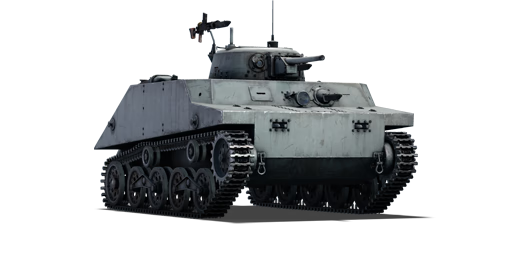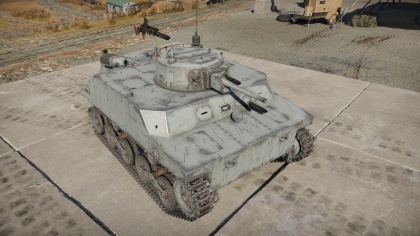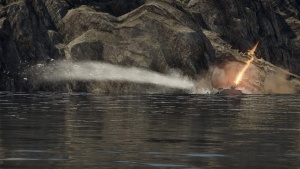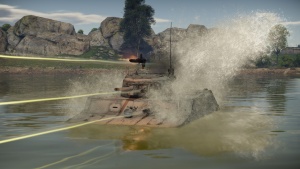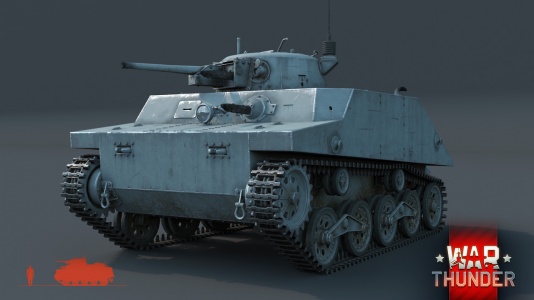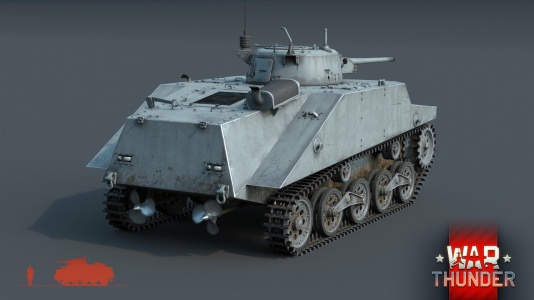Ka-Mi
Contents
Description
The Type 2 Ka-Mi is a rank I Japanese light tank
with a battle rating of 1.0 (AB/RB/SB). It was introduced along with the entire initial Japanese Ground Forces tree in Update 1.65 "Way of the Samurai". An interesting thing about this tank is that it does feature propellers on the backside, because it is amphibious and can allow players to exploit aquatic terrain to their advantage in War Thunder.
General info
Survivability and armour
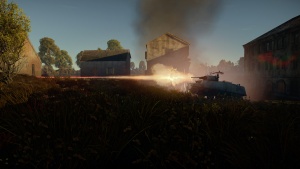
The Ka-Mi is features a very unusual layout. Being originally designed as an amphibious tank, it is very lightly armoured. With an armour ranging around 8 mm to 12 mm on larger portions of the hull, this tank is very fragile to anything bigger than MG fire. To increase survivability, one can enter a fight rearwards in order to absorb shots with the engine, though using hard cover (such as hills and rocks) is preferable.
This armour pattern really shines at distances (500+ m), where a little angling can mostly defeat HMG fire. Since most guns at this BR are quite inaccurate, exposing only your small turret should not be a problem since it is hard to hit. If caught in an open field ( still at distances), try facing directly your foe since angling is useless with such little armour values, that way, some shells can just fly by your crew in the inhabited portions of the tank (ammo racks located there are pretty small, they are often missed in these cases).
The 37 mm is a decent gun with a good reload time and good ammo count: don't bother wasting a shot, fire on the move. This tank has a "lock", which is a primitive form of gun stabiliser, decreasing vertical movement from the main armament - at low speeds, gun handling sees significant improvement. Note that turret rotation speed is somewhat slow: pre-aim your gun in the general direction of the enemy in close-quarter engagements.
One thing that saves the Ka-Mi's reputation is its MG count: there is 3 of them. One is coaxial, fired by gunner, another is pintle-mounted, fired by the gunner and the last one is hull-mounted, fired by the machine-gunner. These weapons have a good burst capacity to take out light targets (soviet SPAA trucks, open-topped SPGs, etc.). This also allows the Ka-Mi to become an unlikely SPAA, armed with three machine guns and a cannon. It can quite easily take down low-flying biplanes that may appear in the hands of inexperienced pilots at Rank I, although it requires sustained hits to successfully down an aircraft. One downside of the Type 97 machine gun is its low ammo count, which limits bursts to a couple of seconds before having to reload. Reloads, fortunately, don't take long.
The Ka-Mi provides a decent top speed on road but lacks power when going off-road. Narrow tracks make mobility in snow/desert maps really painful. A good thing to mention: this tank has a respectable reverse speed of -11 km/h with two reverse gear, which is a rare feature at this BR. It can sometimes get you out of bad situations.
Armour type:
- Rolled homogeneous armour
| Armour | Front | Sides | Rear | Roof |
|---|---|---|---|---|
| Hull | 12 mm (30°) Front plate 6 mm (83°) Front glacis 12 mm (4-39°) Lower glacis |
10 mm | 10 mm (12°) Middle 12 mm (59°) Side |
6 mm |
| Turret | 12 mm (0-8°) Turret front 30 mm Gun mantlet |
12 mm (10-12°) | 12 mm (12-13°) | 6 mm |
Notes
- Suspension wheels and tracks are both 15 mm thick.
- Belly armour is 6 mm thick.
Mobility
Comparing to other tanks in its BR (1.0) Ka-Mi has an average mobility with no weak points, offering an ability to reach most destinations with a bulk of the team, or to pick preferable locations in just about a right time. Vehicle is somewhat prone to sliding in a tight turn during rapid turns at a maximum speed.
The Ka-Mi travels at 10 km/h (AB/RB/SB) in water but can't propel itself backwards. Trajectory should be planned accordingly to avoid being stuck.
| Game Mode | Max Speed (km/h) | Weight (tons) | Engine power (horsepower) | Power-to-weight ratio (hp/ton) | |||
|---|---|---|---|---|---|---|---|
| Forward | Reverse | Stock | Upgraded | Stock | Upgraded | ||
| Arcade | 45 | 12 | 9.1 | 125 | 219 | 13.74 | 24.07 |
| Realistic | 40 | 10 | 102 | 115 | 11.21 | 12.64 | |
Armaments
Main armament
Main gun of the Ka-Mi is a very basic 37 mm cannon with a decent penetration and spread. Its major disadvantage is in a slow turn rate, making it preferable to have turret pre-adjusted before emerging from cover, and similarly hiding it once enemy emerges from a different direction. It does, however, feature a good depression rate, making it a potent weapon when attacking from the hills.
| 37 mm Type 1 | |||||
|---|---|---|---|---|---|
| Capacity | Vertical guidance |
Horizontal guidance |
Stabilizer | ||
| 132 | -10°/+24° | ±180° | Vertical | ||
| Turret rotation speed (°/s) | |||||
| Mode | Stock | Upgraded | Prior + Full crew | Prior + Expert qualif. | Prior + Ace qualif. |
| Arcade | 7.2 | 10.0 | 12.1 | 21.4 | 22.78 |
| Realistic | 7.2 | 8.5 | 10.3 | 11.4 | 12.1 |
| Reloading rate (seconds) | |||||
| Stock | Prior + Full crew | Prior + Expert qualif. | Prior + Ace qualif. | ||
| 5.2 | 4.6 | 4.2 | 4.0 | ||
Ammunition
It's highly preferable to use the Type 1 APHE ammunition over the stock one, due to its significantly better penetration and explosive filler. While Type 94 might simply damage enemy crew or components with anything bar a direct hit, the Type 1 will nearly always result in an actual destruction of the subsystems. Similarly penetration characteristics of the shells make a difference between bouncing and a successful kill, even when dealing with other BR 1.0 tanks.
| Penetration statistics | |||||||
|---|---|---|---|---|---|---|---|
| Ammunition | Type of warhead |
Penetration in mm @ 90° | |||||
| 10m | 100m | 500m | 1000m | 1500m | 2000m | ||
| Type 94 APHE | APHE | 46 | 44 | 36 | 29 | 23 | 18 |
| Type 1 APHE | APHE | 57 | 54 | 39 | 26 | 18 | 12 |
| Shell details | ||||||||||
|---|---|---|---|---|---|---|---|---|---|---|
| Ammunition | Type of warhead |
Velocity in m/s |
Projectile Mass in kg |
Fuse delay
in m: |
Fuse sensitivity
in mm: |
Explosive Mass in g (TNT equivalent): |
Normalization At 30° from horizontal: |
Ricochet: | ||
| 0% | 50% | 100% | ||||||||
| Type 94 APHE | APHE | 700 | 0.7 | 1.2 | 9 | 9.4 | 47° | 60° | 65° | |
| Type 1 APHE | APHE | 800 | 0.72 | 1.2 | 9 | 10.24 | 47° | 60° | 65° | |
Ammo racks
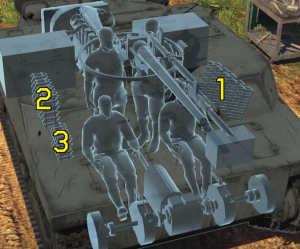
Due to a high maximum ammo capacity of the tank, leaving at least the first ammo rack empty could be preferred for reduced chance of explosion upon hit. This can be done by reducing ammo count to 73 or less. Furthermore, when angling the tank to the enemy, it's preferred to expose left side more towards the enemy, as the right side is the one always storing ammunition, and should be protected when possible.
| Full ammo |
1st rack empty |
2nd rack empty |
3rd rack empty |
Visual discrepancy |
|---|---|---|---|---|
| 132 | 73 (+59) | 25 (+107) | 1 (+131) | No |
Machine guns
The Ka-Mi has a rare setup in its BR, featuring a group of three 7.7 mm what allows it to quickly dispose of enemy soft body vehicles, most notably: anti-aircraft guns of the Rank 1. That said though, all of them are supplied by a very short magazine, allowing for a limited burst before having to reload. In effect shorter bursts in a different portions of the enemy are recommended over a long, sweeping series.
| 7.7 mm Type 97 | ||||||
|---|---|---|---|---|---|---|
| Coaxial mount | ||||||
| Capacity (Belt capacity) | Fire rate (shots/minute) |
Vertical guidance |
Horizontal guidance | |||
| 4,000 (20) | 499 | N/A | N/A | |||
| Hull mount | ||||||
| Capacity (Belt capacity) | Fire rate (shots/minute) |
Vertical guidance |
Horizontal guidance | |||
| 3,000 (20) | 499 | -11°/+35° | ±20° | |||
| Pintle mount | ||||||
| Capacity (Belt capacity) | Fire rate (shots/minute) |
Vertical guidance |
Horizontal guidance | |||
| 1,000 (20) | 499 | -10°/+70° | ±60° | |||
Usage in battles
With its average armour, firepower and mobility, the Ka-Mi should be played wisely, with a bit of finesse: you will not survive frontal engagement, neither can you flank nor snipe...so what's left? Support. Always play as a team when driving the Ka-Mi, bringing an additional potent close-range gun to the fight, threatening your foes while more potent allies reload.
Use hills to your advantage, fall back when outnumbered and beware difficult terrain since it can slow down your manoeuvres. Do not rely on the armour as, even with angling, its effective armour protection is always penetratable by enemy tanks.
Modules
| Tier | Mobility | Protection | Firepower | ||
|---|---|---|---|---|---|
| I | Tracks | Parts | Horizontal Drive | ||
| II | Suspension | Brake System | FPE | Adjustment of Fire | Type 1 APHE |
| III | Filters | Crew Replenishment | Elevation Mechanism | ||
| IV | Transmission | Engine | Artillery Support | ||
Pros and cons
Pros
- 37 mm gun has decent post-penetration damage
- Has a lot of machine guns, allowing a mediocre amphibious tank to turn into an impromptu SPAA instantly
- Tiny turret. Hard to target it at the range
- High ammo count (both cannon and MG)
- 10° gun depression
- Decent reverse speed (-11 km/h)
- Has a coaxial machine gun, unlike most low rank Japanese tanks
- Amphibious design will float on water
Cons
- 37 mm penetration value starting to feel lacking
- Hull size is wider than other Japanese light tanks
- Hull front plate is thin and relatively unsloped
- Tiny turret, big hull. People with have no trouble targeting you
- Only two ammo choice, both APHE, one is clearly superior over the other
- Narrow tracks means poor off-road mobility
- Low engine HP makes hill-climbing only possible at low gear, which even then is difficult
- Weak armour makes you an easy target for aircraft with high penetration on their guns
History
Development
While the tanks were mainly in the Imperial Japanese Army (IJA), the Imperial Japanese Navy (IJN) also owned their own land forces known as the Special Naval Landings Forces (SNLF). Their standard tanks was the Type 95 Ha-Go, but the SNLF wanted a more capable tank for the role, namely one fitted for amphibious landings. The Japanese have touched upon the amphibious tank concept since the 1930s, but one for the rough seas needed more durability than one for rivers. The IJN approached Mitsubishi in 1941 to develop the new amphibious tank, named Ka-Mi "Special Craft". The tank was to go along with the IJA's Type 2 Ke-To light tank, using a similar turret design. The suspension of the vehicle was one derived from the Ha-Go. The amphibious capability was given to the tank via two removable pontoons on the front and back of the tank. A trunk and tower was fitted over the engine and turret respectively to prevent water from flowing into the engine and crew compartment. The vehicle, accepted as the Type 2 Ka-Mi, began production in 1943. Up to 182 tanks were produced from then until the end of the war.[1]
Combat Usage
The Type 2 Ka-Mi saw use in the combat in 1944 in Saipan and Leyte.[1] They assisted the stationed SNLF units on these islands in attacking the American beachheads via amphibious assaults. The Ka-Mi were also stationed in Luzon as a handful were captured by Allied forces in 1945. Their limited numbers and usage meant they fought with relative obscurity to the IJA's Type 97 Chi-Ha tanks. However, the Type 2 Ka-Mi was deemed rather successful by the IJN, some have dubbed it the "best designed amphibious tank of the war" after World War II. This led to the successors like the Type 3 Ka-Chi, a parallel to the Type 1 Chi-He, and the Type 5 To-Ku, based off the Type 5 Chi-Ri.
Media
References
Read also
Sources
| Japan light tanks | |
|---|---|
| Type 89 | I-Go Ko |
| Type 95 | Ha-Go · Ha-Go Commander |
| Type 98 | Ke-Ni |
| Other | Ka-Mi |
| IFV | Type 89 |
| RCV | Type 87 RCV (P) · Type 87 RCV · CTWV RCV |
| MCV | Type 16 (P) · Type 16 (FPS) · Type 16 |
| USA | ▅M24 · ▅M41A1 |


